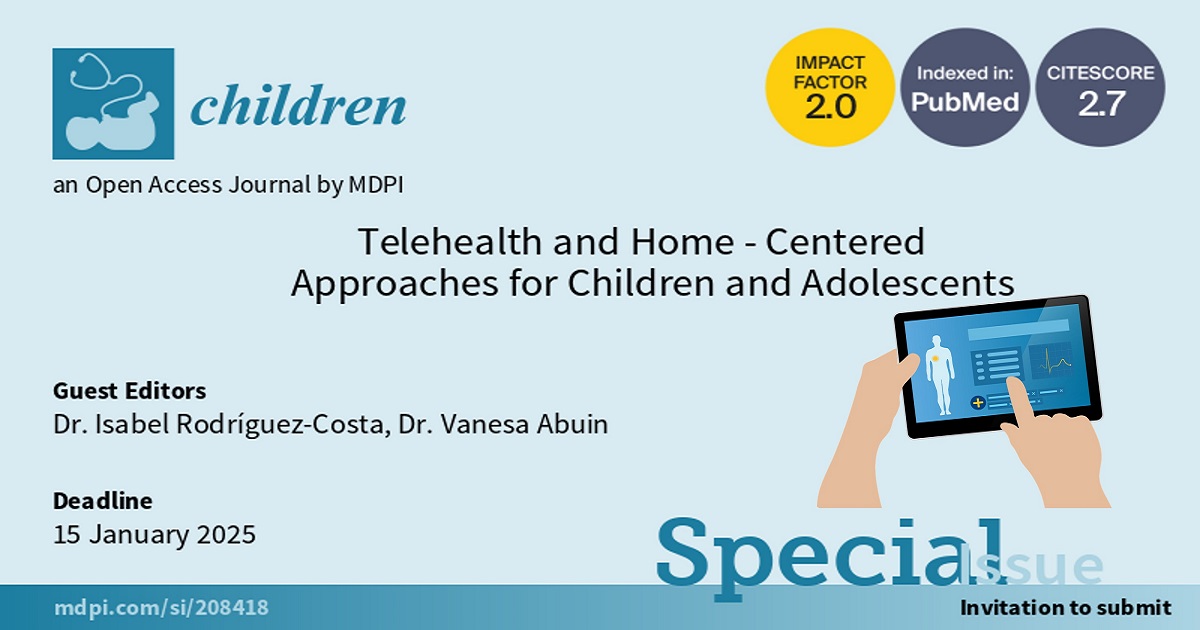Telehealth and Home-Centered Approaches for Children and Adolescents
A special issue of Children (ISSN 2227-9067). This special issue belongs to the section "Pediatric Nursing".
Deadline for manuscript submissions: closed (15 January 2025) | Viewed by 5143

Special Issue Editors
Interests: physiotherapy; children; telehealth; home-centered approaches
Special Issues, Collections and Topics in MDPI journals
Interests: physiotherapy; children; telehealth; home-centered approaches
Special Issues, Collections and Topics in MDPI journals
Special Issue Information
Dear Colleagues,
Telehealth and home-centered approaches are transforming pediatric healthcare by enhancing care access and quality, particularly in underserved regions. The evolution of telehealth has gained significant momentum and was especially highlighted during the COVID-19 pandemic, which emphasized the need for remote healthcare solutions. Over time, telehealth and home-centered approaches have aimed to bridge the gap in healthcare disparities and improve outcomes for children and adolescents worldwide.
Telehealth and home-centered approaches have a long history of increasing healthcare accessibility for pediatric populations. The concept of telehealth dates back to the early 20th century, but it has seen remarkable growth and increased sophistication in recent decades due to advancements in technology and telecommunications. The COVID-19 pandemic accelerated its adoption, demonstrating its critical role in maintaining continuity of care when traditional in-person visits were not feasible. Telehealth and home-centered approaches encompass a range of services, including remote consultations, telemonitoring, and digital therapeutics, and have proven to be an effective tool in managing chronic conditions, providing mental health support, and delivering urgent care.
The integration of telehealth and home-centered approaches into pediatric care has shown promising results in improving access to specialists, reducing travel time and costs for families, and ensuring timely medical interventions. Telehealth has also played a crucial role in addressing the mental health needs of children and adolescents, offering a convenient and less stigmatizing option for accessing psychological support. Given the increasing prevalence of chronic diseases and mental health issues among young people, the role of telehealth and home-centered approaches in pediatric healthcare is more significant than ever.
Aim and Scope of the Special Issue: This Special Issue will explore the multifaceted applications of telehealth and home-centered approaches in pediatric care, from technological advancements to policy implications and clinical outcomes. We seek to gather comprehensive research that assesses the effectiveness, challenges, and potential of telehealth and home-centered approaches for children and adolescents.
Cutting-Edge Research: We invite contributions presenting innovative research, case studies, systematic reviews and meta-analyses. We are particularly interested in studies that highlight technological innovations, clinical effectiveness, patient and family satisfaction, and the broader impacts of telehealth and home-centered approaches on healthcare delivery systems.
What Kind of Papers We Are Soliciting: For this Special Issue, we are seeking articles that address various aspects of pediatric telehealth and home-centered approaches, including, but not limited to, the following:
- Technological innovations in telehealth for children and adolescents;
- Impact of telehealth and home-centered approaches on healthcare accessibility and equity;
- Clinical outcomes and patient satisfaction in pediatric telehealth;
- Policy and regulatory challenges in the implementation of telehealth;
- Telehealth applications in mental health services for children and adolescents.
We welcome submissions from researchers around the globe on this timely and impactful topic. Both reviews and original research articles will be considered.
Dr. Isabel Rodríguez-Costa
Dr. Vanesa Abuin
Guest Editors
Manuscript Submission Information
Manuscripts should be submitted online at www.mdpi.com by registering and logging in to this website. Once you are registered, click here to go to the submission form. Manuscripts can be submitted until the deadline. All submissions that pass pre-check are peer-reviewed. Accepted papers will be published continuously in the journal (as soon as accepted) and will be listed together on the special issue website. Research articles, review articles as well as short communications are invited. For planned papers, a title and short abstract (about 250 words) can be sent to the Editorial Office for assessment.
Submitted manuscripts should not have been published previously, nor be under consideration for publication elsewhere (except conference proceedings papers). All manuscripts are thoroughly refereed through a single-blind peer-review process. A guide for authors and other relevant information for submission of manuscripts is available on the Instructions for Authors page. Children is an international peer-reviewed open access monthly journal published by MDPI.
Please visit the Instructions for Authors page before submitting a manuscript. The Article Processing Charge (APC) for publication in this open access journal is 2400 CHF (Swiss Francs). Submitted papers should be well formatted and use good English. Authors may use MDPI's English editing service prior to publication or during author revisions.
Keywords
- pediatric telehealth
- home-centered approach
- healthcare accessibility
- telemedicine innovations
Benefits of Publishing in a Special Issue
- Ease of navigation: Grouping papers by topic helps scholars navigate broad scope journals more efficiently.
- Greater discoverability: Special Issues support the reach and impact of scientific research. Articles in Special Issues are more discoverable and cited more frequently.
- Expansion of research network: Special Issues facilitate connections among authors, fostering scientific collaborations.
- External promotion: Articles in Special Issues are often promoted through the journal's social media, increasing their visibility.
- Reprint: MDPI Books provides the opportunity to republish successful Special Issues in book format, both online and in print.
Further information on MDPI's Special Issue policies can be found here.







